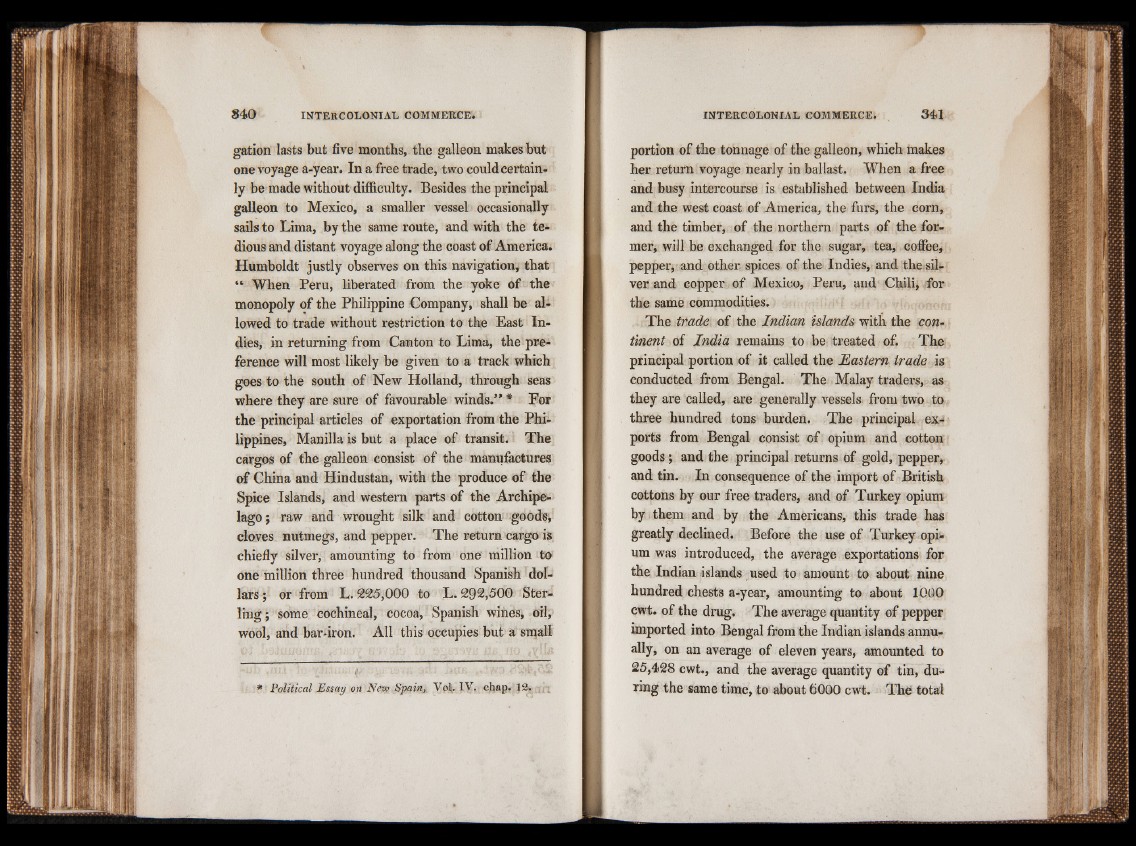
gation lasts but five months, the galleon makes but
one voyage a-year. In a free trade, two eould certain*
ly be made without difficulty. Besides the principal
galleon to Mexico, a smaller vessel occasionally
sails to Lima, by the same route, and with the tedious
and distant voyage along the coast of America.
Humboldt justly observes on this navigation, that
“ When Peru, liberated from the yoke of the
monopoly of the Philippine Company, shall be allowed
to trade without restriction to the East Indies,
in returning from Canton to Lima, the preference
will most likely be given to a track which
goes to the south of New Holland, through seas
where they are sure of favourable winds.” * For
the principal articles of exportation from the Philippines,
Manilla is but a place of transit. The
cargos of the galleon consist of the manufactures
of China and Hindustan, with the produce of the
Spice Islands, and western parts of the Archipelago;
raw and wrought silk and cotton goods,
cloves nutmegs, and pepper. The return cargo is
chiefly silver, amounting to from one million to
one million three hundred thousand Spanish dollars;
or from L. 225,000 to L. 292,500 Sterling
; some cochineal, cocoa, Spanish wines, oil,
wool, and bar-iron. All this occupies but a small
* Political Essay on Nexu Spain, Vol. IV. chap. 12.
portion of the tonnage of the galleon, which makes
her return voyage nearly in ballast. When a free
and busy intercourse is established between India
and the west coast of America, the furs, the corn,
and the timber, of the northern parts of the former,
will be exchanged for the sugar, tea, coffee,
pepper, and other- spices of the Indies, and the.silver
and copper of Mexico, Peru, and Chili, for
the same commodities.
The trade of the Indian islands with the continent
of India remains to be treated of. The
principal portion of it called the Eastern trade is
conducted from Bengal. The Malay traders, as
they are called, are generally vessels from two to
three hundred tons burden. The principal exports
from Bengal consist of opium and cotton
goods; and the principal returns of gold, pepper,
and tin. In consequence of the import of British
cottons by our free traders, and of Turkey opium
by them and by the Americans, this trade has
greatly declined. Before the use of Turkey opium
was introduced, the average exportations for
the Indian islands used to amount to about nine
hundred chests a-year, amounting to about 1000
cwt. of the drug. The average quantity of pepper
imported into Bengal from the Indian islands annually,
on an average of eleven years, amounted to
25,428 cwt., and the average quantity of tin, during
the same time, to about 6000 cwt. The total